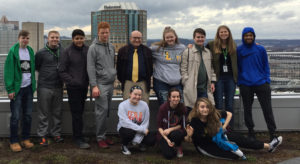 Sitting in the heart of Pittsburgh, the Energy Innovation center stands as a symbol of the changes taking place within the city. Once the Clifford B. Connelley Trade School, the Energy Innovation Center functions as a prototype example of taking an older style building and bringing it into the next century while still keeping the charm it possesses as a landmark of the city of Pittsburgh. On February 23rd, 2018 ten Students and two teachers from Seton LaSalle High School we gave the opportunity to tour the Energy Innovation Center, and see first hand the way a historical monument comes together with a sustainable future model.
Sitting in the heart of Pittsburgh, the Energy Innovation center stands as a symbol of the changes taking place within the city. Once the Clifford B. Connelley Trade School, the Energy Innovation Center functions as a prototype example of taking an older style building and bringing it into the next century while still keeping the charm it possesses as a landmark of the city of Pittsburgh. On February 23rd, 2018 ten Students and two teachers from Seton LaSalle High School we gave the opportunity to tour the Energy Innovation Center, and see first hand the way a historical monument comes together with a sustainable future model.
 The Energy Innovation Center is still being used to educate but is now gone away from the trades that the city of Pittsburgh was once known for. Their mission is to contribute to socially responsible workforce development, foster energy and sustainable technology advancement, and assist in job creation through a commitment to diversity, innovation and comprehensive education. It is referred to as a “green” energy center, a center for research and job training in the energy fields, including new, sustainable energy systems. Wind energy was the topic of our STEM Tour and a particular interest to the students working on a classroom book project, The Boy, the Bird, and the Turbine.
The Energy Innovation Center is still being used to educate but is now gone away from the trades that the city of Pittsburgh was once known for. Their mission is to contribute to socially responsible workforce development, foster energy and sustainable technology advancement, and assist in job creation through a commitment to diversity, innovation and comprehensive education. It is referred to as a “green” energy center, a center for research and job training in the energy fields, including new, sustainable energy systems. Wind energy was the topic of our STEM Tour and a particular interest to the students working on a classroom book project, The Boy, the Bird, and the Turbine.
Within the walls of the Center you’ll find corporations and startups, and universities like Penn State and Pitt. Soon UPMC will be moving in and using a new state of art surgical suite in order to train sanitary operating room practices. While they didn’t get to step inside, a tour guide pointed out the Electric Power Technologies Laboratory led by Dr. Reed. The lab focuses on advanced electric power grid and energy generation, transmission, and distribution-system technologies; power electronics and control technologies; renewable energy systems and integration; smart grid technologies and applications; and energy-storage development.
Training at the Energy Innovation Center focuses on industry required certifications and skills Courses are currently available in
- Energy Safety Passport
- Introduction to the Trades`
- Scalo Professional Roofing Training
- Surface Restoration and Treatment
- Underground Utility Job Readiness Training (Coming Soon)
- Fundamentals of Project Management
- Essentials For Project Management
 The Introduction to the Trades class is a unique introductory overview to building trades. During the six-week course, participants are exposed to a wide range of skilled occupations, through field trips to state-of-the-art union training facilities, hands-on activities, and meetings with expert craftspeople representing 18 local trade unions. In addition, the classroom portion introduces key job readiness skills needed to begin a career in the building and construction trades. Upon completion, successful participants will have the option of taking the next step and applying for union apprenticeship.
The Introduction to the Trades class is a unique introductory overview to building trades. During the six-week course, participants are exposed to a wide range of skilled occupations, through field trips to state-of-the-art union training facilities, hands-on activities, and meetings with expert craftspeople representing 18 local trade unions. In addition, the classroom portion introduces key job readiness skills needed to begin a career in the building and construction trades. Upon completion, successful participants will have the option of taking the next step and applying for union apprenticeship.
The students were amazed by the environmentally friendly technical innovations that are quickly becoming the norm for the city. Innovations including water soaking asphalt in the parking lot and a vertical wind turbine to help supplement energy for the building. On the outside the box type of idea for the cooling system of the building, Joseph Rouse had this to say “I like this place the best. It is so cool how they did the big containers of ice in the swimming pool for the air conditioning of this building!”
Dr. Anthony DeCaria, the students’ science teacher at Seton LaSalle High School, summed up the true purpose of the EIC when he said “It seems like a good place to launch an idea. It is a great environment for the cross-pollination of thoughts and collaboration.”
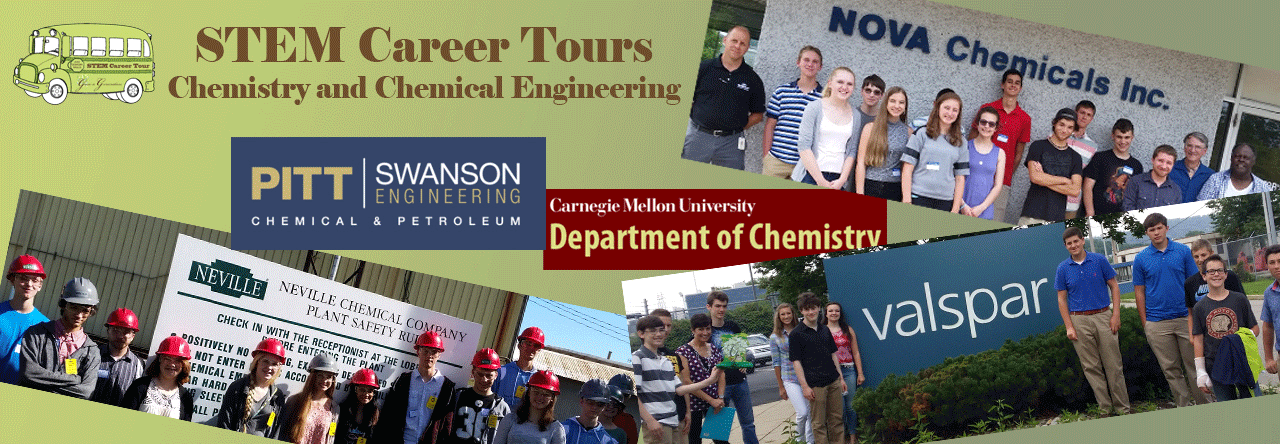
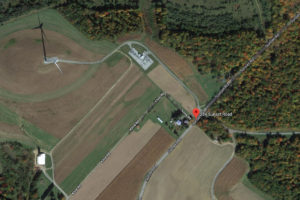 On February 23rd, 10 Students from Seton La Salle High School and a pair of their teachers visited a wind farm located in the heart of Patton Township. They stepped from the bus into driving rain and a wind that blew against them stinging their faces. They met, huddled together among the cold and rain, with Michael Hoffman the Highland Assistant Site Manager for Everpower Wind Holdings.
On February 23rd, 10 Students from Seton La Salle High School and a pair of their teachers visited a wind farm located in the heart of Patton Township. They stepped from the bus into driving rain and a wind that blew against them stinging their faces. They met, huddled together among the cold and rain, with Michael Hoffman the Highland Assistant Site Manager for Everpower Wind Holdings.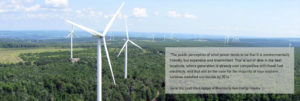

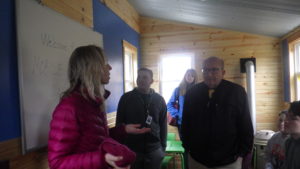 On Friday, February 23 2018, ten students and two teachers from Seton La Salle High School were invited to speak with the faculty and staff at the St. Francis University Institute for Energy Research. This visit was planned in conjunction with a fellowship project that the students are hard at work on, writing a children’s book on wind energy (The Boy, The Bird, and the Wind Turbine – coming in May!)
On Friday, February 23 2018, ten students and two teachers from Seton La Salle High School were invited to speak with the faculty and staff at the St. Francis University Institute for Energy Research. This visit was planned in conjunction with a fellowship project that the students are hard at work on, writing a children’s book on wind energy (The Boy, The Bird, and the Wind Turbine – coming in May!)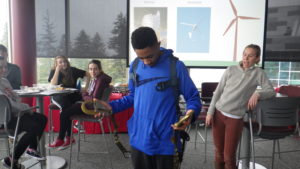 This information proved very valuable to the students, who had been given a very real connection to the material they were writing about. Tyler Hill, after trying on the harness used to climb some of the smaller (150 foot) turbines said, “My favorite place was the university because I learned more about how turbines work, how gears move and how the windmill turns to face the direction of the wind.” Another classmate Carrie Martson stated, “I wish we had more time there.” While Joshua Mellor shared, “Saint Francis was the place for me because I could listen to the presentation and now I know a little more about how windmills work.”
This information proved very valuable to the students, who had been given a very real connection to the material they were writing about. Tyler Hill, after trying on the harness used to climb some of the smaller (150 foot) turbines said, “My favorite place was the university because I learned more about how turbines work, how gears move and how the windmill turns to face the direction of the wind.” Another classmate Carrie Martson stated, “I wish we had more time there.” While Joshua Mellor shared, “Saint Francis was the place for me because I could listen to the presentation and now I know a little more about how windmills work.”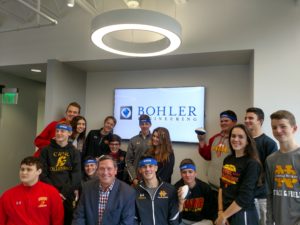 On November 17, The Students of Mrs. Steiniger’s Biology class from Cardinal Wuerl North Catholic arrived at the brand new Pittsburgh office of Bohler Engineering for a STEM Career tour all about sustainability. Bohler has been consulting on land development projects for a few decades now, and while not always demanded, they do consistently attempt to add as many green touches as possible to their projects.
On November 17, The Students of Mrs. Steiniger’s Biology class from Cardinal Wuerl North Catholic arrived at the brand new Pittsburgh office of Bohler Engineering for a STEM Career tour all about sustainability. Bohler has been consulting on land development projects for a few decades now, and while not always demanded, they do consistently attempt to add as many green touches as possible to their projects.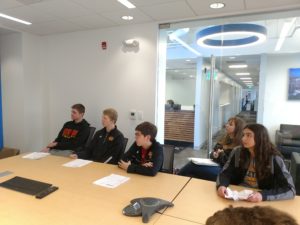 Mr. Takacs was also able to share knowledge of other sustainable projects of note and interest within the city, including a recently constructed building that can be opened up and cooled passively with natural air currents.
Mr. Takacs was also able to share knowledge of other sustainable projects of note and interest within the city, including a recently constructed building that can be opened up and cooled passively with natural air currents.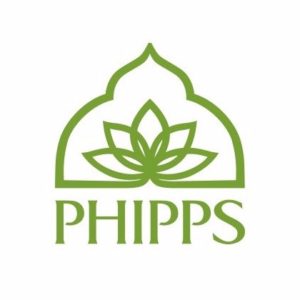 ovember 17th Mrs. Steiniger’s Biology class from Cardinal Wuerl North Catholic High School toured the Center For Sustainable Landscapes at Phipps Conservatory, as part of Sustainability Stem Career Tour. The Center For Sustainable Landscapes is one of the greenest buildings in the world, meeting the requirements of the Living Building Challenge the strictest classification for a green building project.
ovember 17th Mrs. Steiniger’s Biology class from Cardinal Wuerl North Catholic High School toured the Center For Sustainable Landscapes at Phipps Conservatory, as part of Sustainability Stem Career Tour. The Center For Sustainable Landscapes is one of the greenest buildings in the world, meeting the requirements of the Living Building Challenge the strictest classification for a green building project.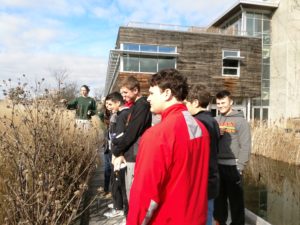
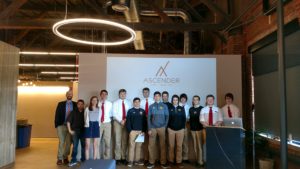 Cardinal Wuerl North Catholic’s AP Computer Science Principles class recently toured the offices of Ascender in Pittsburgh. Ascender is the next step in evolution of venture capitalism growing out the work the company did under the name Thrill Mill. Instead of merely providing funds for companies to begin work on making a viable product, Ascender takes this much farther. In addition to capital, they provide everything from mentoring and leadership to office space and team building resources. Moreover, they are continuing to find ways to do so much more.
Cardinal Wuerl North Catholic’s AP Computer Science Principles class recently toured the offices of Ascender in Pittsburgh. Ascender is the next step in evolution of venture capitalism growing out the work the company did under the name Thrill Mill. Instead of merely providing funds for companies to begin work on making a viable product, Ascender takes this much farther. In addition to capital, they provide everything from mentoring and leadership to office space and team building resources. Moreover, they are continuing to find ways to do so much more.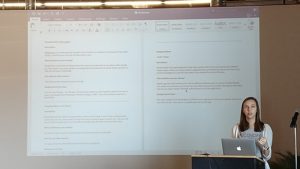 Leading the tour was Jennifer Sharpe, Program Manager for Ascender, who also gave an informative and stimulating presentation on everything that Ascender does to help make STEM based industry in the city of Pittsburgh grow. As a part of the presentation, she had the students participate in an exercise mirroring the process by which companies are selected for Ascender’s incubation chamber. The students were given three pitches by various potential companies, including team members, and the product idea. After careful consideration, the determination had to be made as to which idea was most viable to make a profit.
Leading the tour was Jennifer Sharpe, Program Manager for Ascender, who also gave an informative and stimulating presentation on everything that Ascender does to help make STEM based industry in the city of Pittsburgh grow. As a part of the presentation, she had the students participate in an exercise mirroring the process by which companies are selected for Ascender’s incubation chamber. The students were given three pitches by various potential companies, including team members, and the product idea. After careful consideration, the determination had to be made as to which idea was most viable to make a profit. 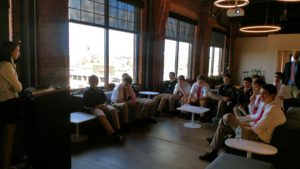 Jennifer also included information on “Thrival,” Ascender’s yearly music festival and innovation conference. Part of the mission of Ascender is to help usher in a new wave of modern industry. By converting an old Steel Mill into a place where people can come together with new ideas, Ascender is poised to help bring Pittsburgh into the here and now of STEM industry.
Jennifer also included information on “Thrival,” Ascender’s yearly music festival and innovation conference. Part of the mission of Ascender is to help usher in a new wave of modern industry. By converting an old Steel Mill into a place where people can come together with new ideas, Ascender is poised to help bring Pittsburgh into the here and now of STEM industry.